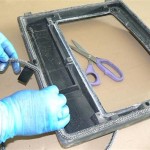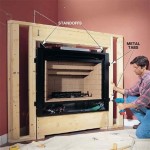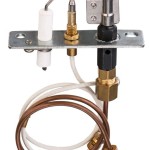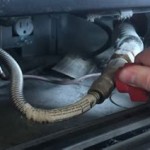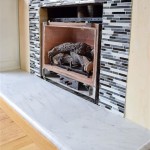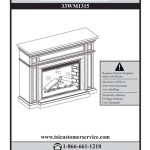Gas Fireplace Inserts: Chimney-Free Options and Considerations
Gas fireplace inserts offer a convenient and efficient alternative to traditional wood-burning fireplaces. For homeowners without existing chimneys, or those seeking to avoid the complexities and costs associated with chimney maintenance, chimney-free gas fireplace inserts present a viable solution. These units utilize specialized venting systems, enabling installation in a wider range of homes and configurations. This article explores the principles, types, benefits, and considerations involved in selecting and installing a gas fireplace insert without a chimney.
Gas fireplace inserts, in essence, are self-contained heating units designed to fit within an existing fireplace opening or be installed as independent appliances. They burn natural gas or propane as fuel and provide supplemental heat to a room, often with the added ambiance of realistic-looking flames. The primary distinction between a standard gas fireplace insert and a chimney-free option lies in the venting system employed.
Traditional gas fireplace inserts rely on existing chimneys to exhaust combustion byproducts. A flue liner is typically installed within the chimney to ensure proper venting and prevent the leakage of harmful gases into the home. In contrast, chimney-free gas fireplace inserts utilize direct vent or vent-free technologies to manage exhaust.
Direct Vent Gas Fireplace Inserts
Direct vent gas fireplace inserts are the most common type of chimney-free option. These units draw combustion air from outside the home and vent exhaust gases directly outdoors through a sealed, two-pipe system. One pipe draws in fresh air, while the other expels combustion products. This closed system ensures that no indoor air is used for combustion, and no exhaust gases enter the living space. Direct vent systems offer enhanced safety and efficiency compared to standard venting methods.
The direct vent system typically consists of two concentric pipes, meaning one pipe is nested inside the other. The inner pipe vents exhaust, and the outer pipe draws in fresh air. The pipes can be routed horizontally through an exterior wall or vertically through the roof, depending on the model and installation requirements. The horizontal venting option makes direct vent inserts particularly suitable for homes without chimneys. The flexibility in venting allows for installation in various locations within a home, not limited by the presence of a pre-existing chimney structure.
The installation of a direct vent gas fireplace insert requires careful planning and adherence to manufacturer specifications and local building codes. A qualified technician should perform the installation to ensure proper venting and safe operation. The vent pipes must be properly sealed and insulated to prevent condensation and heat loss. Regular inspections of the venting system are recommended to maintain its integrity and efficiency.
Direct vent systems provide a significant safety advantage because they isolate the combustion process from the indoor environment. This minimizes the risk of carbon monoxide poisoning and other health hazards associated with incomplete combustion. The sealed system also prevents drafts and heat loss, contributing to improved energy efficiency. The efficiency ratings of direct vent inserts are generally higher than those of vent-free options.
While direct vent inserts require a venting system, the installation is often less expensive and less disruptive than building or repairing a chimney. The venting can be routed through existing walls or ceilings, minimizing the need for extensive renovations. Direct vent fireplaces offer a wide range of styles and sizes to suit various aesthetic preferences and heating needs. The realistic flames and glowing embers create a warm and inviting atmosphere.
Vent-Free Gas Fireplace Inserts
Vent-free gas fireplace inserts, also known as ventless gas fireplaces, represent another option for homeowners lacking a chimney. These units are designed to burn gas so cleanly that they do not require any external venting system. Special burners and oxygen depletion sensors (ODS) are incorporated to ensure complete combustion and prevent the buildup of carbon monoxide. The ODS monitors the oxygen levels in the room and automatically shuts off the gas supply if the levels drop too low, indicating incomplete combustion.
Vent-free gas fireplace inserts operate on the principle of complete combustion, aiming to convert all the fuel into heat, water vapor, and carbon dioxide. However, even with advanced burner technology, vent-free units still produce small amounts of these byproducts. Therefore, it is crucial to ensure adequate ventilation in the room where a vent-free fireplace is installed. Opening a window or door slightly can help to prevent the buildup of moisture and carbon dioxide.
The use of vent-free gas fireplaces is subject to local building codes and regulations. Some jurisdictions prohibit or restrict their use due to concerns about indoor air quality and potential health risks. It is essential to check with local authorities to determine the permissibility of vent-free appliances in a specific location. Manufacturers typically provide clear guidelines on the room size and ventilation requirements for safe operation.
Vent-free gas fireplace inserts offer the advantage of simple installation and lower upfront costs compared to direct vent options. No venting is required, eliminating the need for extensive construction or modifications to the home. These units can be easily installed against an existing wall or within a fireplace opening. However, the long-term operating costs and potential health concerns should be carefully considered.
Despite the safety features incorporated into vent-free gas fireplaces, they are not entirely without risks. The combustion process releases water vapor into the air, which can contribute to humidity and potentially lead to mold growth. Carbon dioxide levels may also increase, especially in poorly ventilated rooms. Individuals with respiratory conditions, such as asthma or allergies, may be particularly sensitive to these changes in indoor air quality.
Regular maintenance is crucial for ensuring the safe operation of vent-free gas fireplaces. The burner should be cleaned periodically to prevent soot buildup and ensure proper combustion. The ODS should be tested regularly to verify its functionality. Carbon monoxide detectors should be installed in the home to provide an early warning in case of a malfunction.
Key Considerations for Chimney-Free Gas Fireplace Inserts
Selecting a gas fireplace insert without a chimney requires careful evaluation of various factors, including the type of venting system, the size and style of the unit, and the overall heating needs of the space. Understanding the specific requirements and limitations of each type of insert is essential for making an informed decision.
Venting System: As previously discussed, the choice between a direct vent and a vent-free system is a primary consideration. Direct vent inserts offer superior safety and efficiency but require a venting system. Vent-free inserts are easier to install but carry potential risks related to indoor air quality. The decision should be based on a thorough assessment of the home environment, local regulations, and individual health concerns. Direct vent fireplaces are generally preferred for their superior safety and efficiency. Vent-free options might be considered only when direct vent installation is impossible and building codes allow it, with careful attention to room size and ventilation.
Size and Heating Capacity: The size of the gas fireplace insert should be appropriate for the size of the room it is intended to heat. A unit that is too small will not provide adequate warmth, while a unit that is too large may overheat the space. Heating capacity is typically measured in British Thermal Units (BTUs). A higher BTU rating indicates a greater heating output. Consult with a qualified professional to determine the appropriate BTU rating for the room size and climate conditions.
Installation and Maintenance: Proper installation is critical for the safe and efficient operation of a gas fireplace insert. A qualified technician should perform the installation to ensure that all connections are secure and that the venting system meets applicable codes. Regular maintenance, including cleaning the burner and inspecting the venting system, is essential for preventing malfunctions and ensuring long-term performance. Hiring a professional for annual inspections and maintenance is recommended. The cost of installation and maintenance should be factored into the overall cost of owning a gas fireplace insert.
Safety Features: All gas fireplace inserts should be equipped with safety features such as a pilot light, a safety shut-off valve, and a carbon monoxide detector. The pilot light ignites the main burner, while the safety shut-off valve automatically shuts off the gas supply if the flame is extinguished. A carbon monoxide detector provides an early warning of potentially dangerous gas leaks. Regularly testing the carbon monoxide detector is crucial.
Aesthetic Appeal: Gas fireplace inserts are available in a wide range of styles and designs to complement various home décor preferences. Options include traditional log sets, contemporary glass media, and realistic flame patterns. The aesthetic appeal of a gas fireplace insert can significantly enhance the ambiance of a room. Choosing a style that aligns with the overall design of the home is an important aspect of the selection process.
Cost Considerations: The cost of a gas fireplace insert can vary depending on the type of venting system, the size and features of the unit, and the complexity of the installation. Direct vent inserts generally cost more than vent-free options. However, the long-term operating costs and potential health risks associated with vent-free units should also be considered. Obtaining quotes from multiple installers and comparing the total cost of ownership is recommended.
Local Regulations and Permits: Before installing a gas fireplace insert, it is essential to check with local authorities to determine any applicable building codes and permit requirements. Some jurisdictions may have specific regulations regarding the type of venting system, the location of the unit, and the installation procedures. Obtaining the necessary permits is crucial for ensuring compliance with local laws and avoiding potential fines or penalties. Adherence to local regulations ensures safety and compliance with established standards.

How To Vent A Gas Fireplace Without Chimney Vertical Care
:max_bytes(150000):strip_icc()/ventless-gas-fireplaces-4160746-hero-f9d4bdcd9bd446eb84406de306f790ba.jpg?strip=all)
How To Pick Out A Ventless Gas Fireplace

Do Gas Fireplaces Need A Chimney Dreifuss

What Is A Ventless Gas Fireplace Experts In Gaithersbutg Md

Install A Fireplace Without Chimney Ventless
.aspx?strip=all)
Fireplaces That Work Without Power Be Storm Ready With Regency

Gas Fireplace Inserts Pros And Cons Of Ventless Fireplaces
.aspx?strip=all)
Fireplaces That Work Without Power Be Storm Ready With Regency

Convert To Gas Installing Fireplace Inserts Doctor Flue

Vent Free Gas Fireplaces Inserts Stoves Napolis Godby Hearth And Home

